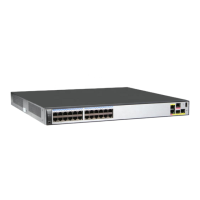NOTE
Different terminal software defines these keys differently. Therefore, the shortcut keys on the terminal may
be different from those listed in this section.
Table 2-7 System-defined shortcut keys
Key Function
CTRL_A The cursor moves to the beginning of the current line.
CTRL_B The cursor moves to the left by the space of a character.
CTRL_C Terminates the running function.
CTRL_D Deletes the character where the cursor lies.
CTRL_E The cursor moves to the end of the current line.
CTRL_F The cursor moves to the right by the space of a character.
CTRL_H Deletes one character on the left of the cursor.
CTRL_N Displays the next command in the previously-used command
buffer.
CTRL_P Displays the previous command in the previously-used
command buffer.
CTRL_W Deletes a character string or character on the left of the cursor.
CTRL_X Deletes all the characters on the left of the cursor.
CTRL_Y Deletes all the characters on the place of the cursor and the right
of the cursor.
CTRL_Z Returns to the user view.
CTRL_] Terminates the inbound or redirection connections.
ESC_B The cursor moves to the left by the space of a word.
ESC_D Deletes a word on the right of the cursor.
ESC_F The cursor moves to the right to the end of next word.
2.4.2 Defining Shortcut Keys
If one or multiple commands are frequently used, you can correlate these commands with
shortcut keys. This facilitates user operation and improves efficiency. Only management-level
users have the rights to define shortcut keys.
Configure as follows in the system view.
Huawei AR2200 Series Enterprise Routers
Configuration Guide - Basic Configuration 2 CLI Overview
Issue 02 (2011-10-15) Huawei Proprietary and Confidential
Copyright © Huawei Technologies Co., Ltd.
19

